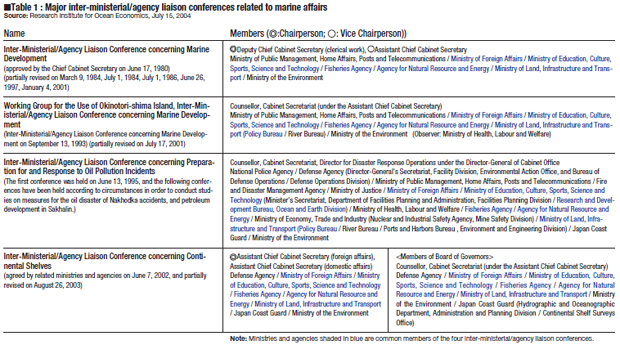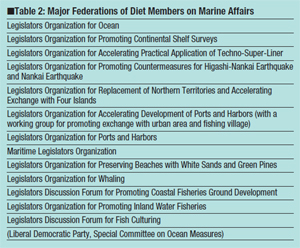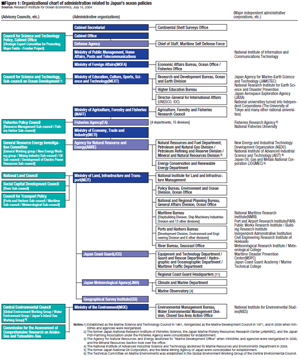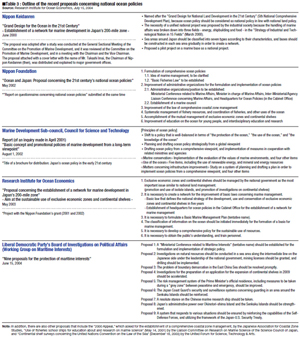Ocean Newsletter
No.96 August 5, 2004
-
A Proposal on Reformation of Japan's Marine Policies
Hiroyuki Nakahara Managing Director, Research Institute for Ocean Economics / Selected Papers No.7(p.19)
Among the above-said problems, I would like to touch upon the problems of Continental Shelf surveys beyond EEZ and oil and gas development in the East China Sea.
Selected Papers No.7(p.19) -
Establishment of the Aquatic Genomics Research Center, and accumulation of information on genes
Ichiro Nakayama Director, Aquatic Genomics Research Center, National Research Institute of Fisheries Science, Fisheries Research Agency
Because there is a wide range of species of marine life, information on DNA and genes, which are said to be the common languages of living things, is important. In order to centralize information on the genes and DNA polymorphism of marine life, and accumulate information on genes for the purpose of efficient breeding, the Aquatic Genomics Research Center was established in April 2004. The background and purpose of the center are summarized.
A Proposal on Reformation of Japan's Marine Policies
Prioritized budgets should be allocated and a comprehensive strategy should be employed for surveys on the Continental Shelves beyond Exclusive Economic Zone. Our government should work on active geophysical exploration and needed exploratory drillings in the Japanese side area along the equidistant line in the East China Sea, and take necessary actions to settle down the boundary dispute based upon Japan's position.
To promote Japan's ocean policies comprehensively and inclusively, it is necessary for us to have clear recognition on the administrative framework from a bird's-eye viewpoint. Then, the Ministry of Land, Infrastructure and Transport (MLIT) should play a pivotal role in the promotion of ocean policies, and the Minister of LIT should be designated as the Minister Extraordinary of Marine Affairs, taking initiative on integration and upgrade of government-wide ocean and coastal policy development and implementation. The Ministerial Marine Policy Conference and Marine Policy Advisory Council should be also established promptly, replacing current status. Also, Ocean Policy Office should be set up in the Cabinet Office in order to manipulate these governance procedures.
This year, four years after we stepped into the 21st century, we celebrate the 10th anniversary after the United Nations Convention on the Law of the Sea entered into force. As far as the problems of Japan's ocean policies, important issues have popped up one after another over these four years. They include problems of suspicious ships and spy ships, problems of needed surveys on Continental Shelves beyond Exclusive Economic Zone, problems of Okinotori-shima Island, problems of the dominion of the Senkaku Islands and Takeshima Island, and problems of boundary dispute and oil and gas development in the East China Sea. Since such various and sensitive problems on marine affairs have emerged all of a sudden, we are in an unprecedented situation in the history of Japan's ocean policies. On the other hand, various opinions and proposals regarding ocean policies were also publicized over the past five years, as indicated in the summaries. (See Table 3) This is also unprecedented in the history of Japan's ocean policies.
Ample budgets should be allocated for Continental Shelf surveys, and a multi-year exploration project should be implemented in Japanese side sea area along the equidistant line in the East China Sea
Among the above-said problems, I would like to touch upon the problems of Continental Shelf surveys beyond EEZ and oil and gas development in the East China Sea.

Regarding former problem, a new inter-ministerial/ agency liaison conference was inaugurated, and the Conti nental Shelf Surveys Office was organized in the Cabinet Secretariat on December 8, 2003. (See Table 1) Such a completely new office setting within the heart portion of the administration is quite epoch-making in the Japanese political history, particularly on ocean policies. In the industrial world, on February 3, 2004, Japan Continental Shelf Survey K.K. was also newly established as a private firm, and started surveying activities upon contract from the government. Furthermore, in the political world, the Federation of Members of the Diet for the Promotion of Continental Shelf Surveys (Chairperson: Ms. Chikage Ohgi, former Minister of Land, Infrastructure and Transport) was also organized as a pressure group.(See Table 2) Plus, Ministry of Foreign Affairs ordered a contract-base study to the Society of Exploration Geophysicists of Japan (SEGJ), and SEGJ began discussion in their Committee on the Study of the Demarcation of Continental Shelves, not only in the technical perspective but also in political ones, so that it examines the trends of other coastal nations, and Japan's political alternatives in a certain degree. Because it seems very crucial to submit application to the United Nation's Commission on the Limits of the Continental Shelf (UNLCS) by May 2009, prioritized budgets for survey activities on the expansion of continental shelves beyond EEZ must be allocated to execute sufficiently and to be done on time. It is needless to say a comprehensive ocean policy strategy is necessary, in order to overcome technical and political obstacles during surveys activities, and to make negotiations effective with UNLCS. Of course, how to manage the expected new jurisdictional continental shelves is essential in such strategy.

With respect to the latter problem, there have been a chain of movements: Ms. Kawaguchi, Minister of Foreign Affairs, requested China to provide data around the production platform near the anticipated equidistant line, the Chinese side probed for a proposal for joint development, Mr. Nakagawa, Minister of Economy, Trade and Industry, mentioned that Japan is ready to start its own surveys and drilling activities, the Chinese side expressed its strong interest, a geophysical survey ship chartered by the Japanese Government left the Port of Naha to execute seismic survey just close to the equidistant line in the East China Sea in July, and Mr. Nakagawa expressed discomfort over activities being done by Chinese marine research ships. In such tense situation, about several months ago, the Working Group on Maritime Interests (Chairperson: Mr. Keizo Takemi, Diet member of Upper House) in the Liberal Democratic Party's Board of Investigations on Foreign Policies publicized a constructive proposal with regard to a series of the movements described above. It includes geophysical exploration in a sea area along the equidistant line on the Japanese side and exploratory drilling in important points should be started on a full scale as a strongly supported project. Japanese government implemented similar long-term project of exploration in a sea area very close to the Okinawa Islands in the past, but yet in the mid sea area of the East China Sea. At the same time, it says necessary measures should be taken to settle down the boundary dispute, based on Japan's position.
Have a bird's-eye view on ocean policy framework first, and each administrative organization should provide more information
Although each ocean policy problem is unique and inherent, it is related to each other in a complicated manner. For example, the dominion of the Senkaku Islands and Takeshima Island, the problem of boundary demarcation, and measures against suspicious ships and spy ships should be examined and treated as the problems of comprehensive marine management, for which individual policies should be implemented under overall ocean strategy as a whole. For the reference, the author prepared the above organizational chart (Figure 1) in order to understand administrative framework related to Japan's marine affairs from a bird's-eye viewpoint.
Eight ministries and six agencies are related to Japan's marine affairs, in addition to the Cabinet Secretariat. There are eight related advisory councils (over 10, including subcouncils). There are also four inter-ministerial/agency liaison conferences, which include individual sub-conferences with members of different levels, as indicated in the table 1. Taking these formations into account, there are a total of eleven ministries and eight agencies related to national marine affairs, and there are about twenty major independent administrative corporations.

Now, how much do we know about the actual activities of the respective organizations, in particular, administrative- related trends? For example, in the Inter-Ministerial/ Agency Liaison Conference related to Marine Affairs held on August 20, 2002, it was agreed to increase regular meetings from once a year in July to twice a year in January and July, to place the re-classification of marine-related laws on the agenda, and to provide sub-conferences to handle themes crossing over plural ministries and agencies. It seems that the existence of the Working Group of the Use of Okinotori-shima Island, which was established under the Inter-Ministerial/Agency Liaison Conference, is not being known at all, but the working group has been continuously holding meetings once or twice a year. The Inter-Ministerial/ Agency Liaison Conference concerning Preparation for and Response to Oil Pollution Incidents has been held continuously whenever pollution incidents such as Nakhodka accidents occurred, and held its sessions seven times from September 1999 to January 2004 in order to examine countermeasures against oil spills that may happen in relation to oil and gas development in Sakhalin.
The actual structures and discussions in such framework are very difficult to know from outside. This tells us that we need to make more effort to know and to learn them, and also brings out the point that government offices are not necessarily providing enough information. When we discuss marine policies, we must take consideration with such knowledge and information in order to stand upon more comprehensive perspectives. Therefore we hope that more information would be publicized and provided, though necessary limitation and consideration may also be given.
The Minister of Land, Infrastructure and Transport should act as the Minister Extraordinary of Marine Affairs, and Ministerial Conferences on Ocean Policies should be organized as soon as possible

Though proposals, made by Nippon Keidanren in 2000 and by Nippon Foundation in 2002, requiring government structure reorganization, were introduced and discussed during the process of deliberation in the Marine Development Sub-council of the Council for Science and Technology, its official report publicized on August 1, 2002, only mentioned the necessity of "a study on a system of planning and drafting a plan in order to implement ocean policies from a comprehensive viewpoint." On the other hand, a proposal submitted from political circles by the Working Group on Maritime Interests in June 2004 was derived from such previous proposals, which was to be estimated further advanced and developed.
The author therefore came up with the following tentative proposal as follows, taking account of precedent proposals: First, Minister Extraordinary of Marine Affairs should be set up, and the Minister of Land, Infrastructure and Transport should be appointed to that position. The details of discussions held in each council related to marine affairs, and the cross-sectional issues of all administrative organizations should be reported to the Minister of Extraordinary, and government-wide comprehensive and integrated policies should be promoted under the leadership of the Minister Extraordinary of Marine Affairs. In other words, my proposal is that the current situation, under which the Ministry of Education, Culture, Sports, Science and Technology takes charge of both of responsibilities on marine science and technology, and on the entire national ocean policies coordination, should be resolved, and that the Minister of Land, Infrastructure and Transport should play a pivotal role in coordination and promotion of national ocean policies as a whole. Of course, it is necessary to divide work into fisheries, resource and energy, science and technology, diplomacy, and environmental issues as previously being done though, pivotal manipulating functions should be reinforced in order to ensure and upgrade the integration of ocean policies and its implementation.
The reasons why I centered around the Ministry of Land, Infrastructure and Transport(MLIT) are; firstly that MLIT is in charge of coastal zone management, and its coverage is now more than 70% of the total of Japan's 35,000km long coastline; secondly that far-isolated islands in the Pacific Ocean which are important for the management of exclusive economic zone, including Okinotori-shima Island, are managed mostly by the MLIT; and thirdly I believe that the ocean should be managed as equivalent to our national land territory where being managed by MLIT. Preparatory activities should be initiated by the leadership of newly appointed Minister Extraordinary of Marine Affairs, and the Ministerial Ocean Policy Conference be called and set up, and the Ocean Policy Office in the Cabinet Office should be established. The mission of the Office is to take charge of the distribution and classification, and the required transmission of all information on policies on the ocean and coastal zones including the world's trends, and fulfill the important functions to promote ocean policy governance procedure among the governmental framework.
In addition, the current Marine Development Sub-council under the Council for Science and Technology should be reorganized as a Marine Science and Technology Subcouncil which focuses on simply on science and technology as an advisory board to MEXT only (it means it gets back to the original organization, predecessor of Marine Development Council), and replaced by a Marine Policy Council that will make deliberations on overall national ocean policies, as well as ideal ways of comprehensive, inter-ministerial, and cross-section policies, should be newly established as a high level advisory board to the Prime Minister.
The improvement of laws and reorganization of administrative structures should be considered as mere expedient, and should not be done merely for their own sake. We should not forget that our purposes are getting better understanding of the ocean and coastal zones, further promotion of sustainable development, vitalization of ocean related industries, and make contribution to the national economy and communities making use of the great potentials of the oceans.
(This article represents only the author's personal opinion, and it does not necessarily represent the opinion of the institution the author belongs to.)
